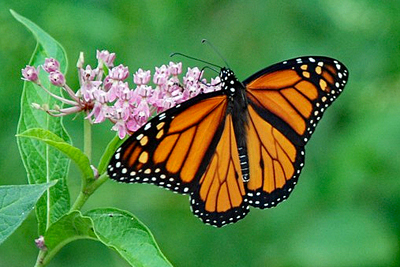Alert:

Beauty in our gardens depends on pollinators. The population of one of those pollinators, the monarch butterfly, is declining. There are efforts underway to reverse that decline.
You can help.
Below are links to organizations fighting to preserve the monarch butterfly, steps you can take to make a place for butterflies at your home, school and park programs about butterflies, and information about the distinctively-marked and colorful monarch.
 All milkweed is toxic. Toxicity protects the monarch butterfly and caterpillar and the dozens of other insects that use milkweed as a host from predation. Basically, the latex sap throughout the plant imbues the muncher with a noxious taste. Plant all milkweeds out of the reach of pets that have a proclivity to chew plants. Typically this is a concern for grazing animals, but no pets should be allowed to eat milkweeds.
All milkweed is toxic. Toxicity protects the monarch butterfly and caterpillar and the dozens of other insects that use milkweed as a host from predation. Basically, the latex sap throughout the plant imbues the muncher with a noxious taste. Plant all milkweeds out of the reach of pets that have a proclivity to chew plants. Typically this is a concern for grazing animals, but no pets should be allowed to eat milkweeds.
Our area milkweeds are not among the most toxic. In order of toxicity, the most potent are labriformis milkweed, western whorled milkweed, western whorled milkweed and wooly pod milkweed. The most toxic of milkweeds are the whorled or narrow leaf varieties.
In our area, the common milkweed, the favorite of monarch butterflies, is not used in public school butterfly gardens due to concerns over toxicity. The swamp milkweed and butterfly weed are commonly planted in schoolyards and parks. Hidden Oaks Nature Center, which is active in monarch conservation, has all three species. Milkweed in different geographic areas can have different levels of toxicity. Our area’s milkweed is less toxic than milkweed in northern states. The biggest concern is getting the toxic sap in the eye. The latex, which contains cardiac glycosides, is a severe irritant and would require medical attention.
